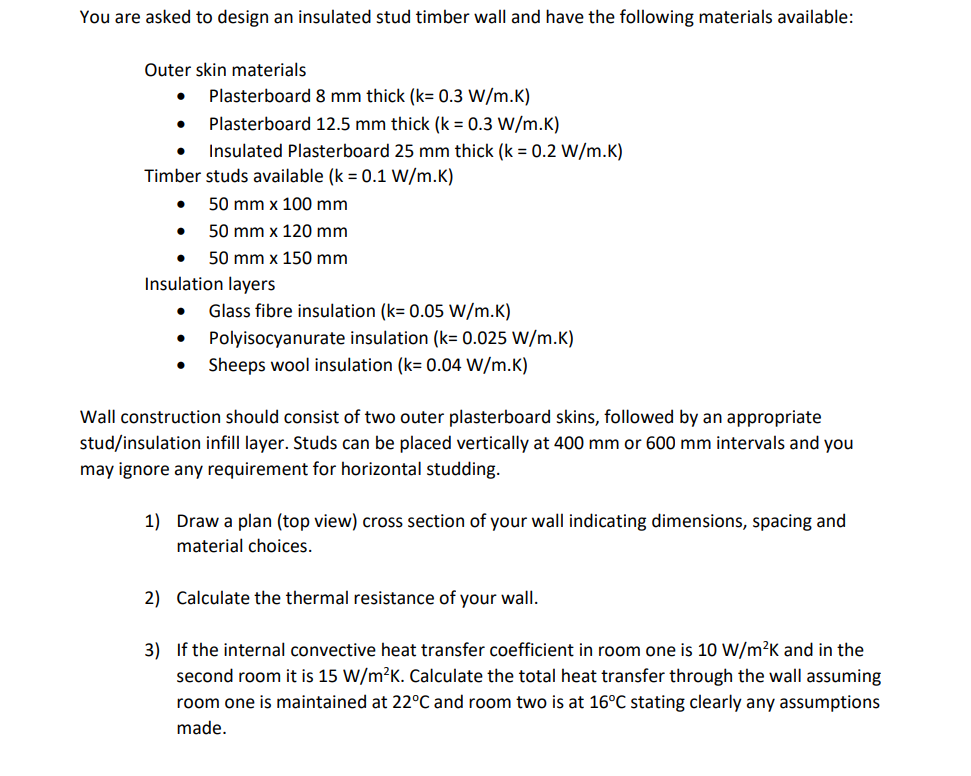You are asked to design an insulated stud timber wall and have the following materials available: Outer skin materials • • Plasterboard 8 mm thick (k= 0.3 W/m.K) Plasterboard 12.5 mm thick (k = 0.3 W/m.K) Insulated Plasterboard 25 mm thick (k = 0.2 W/m.K) Timber studs available (k = 0.1 W/m.K) • 50 mm x 100 mm • 50 mm x 120 mm 50 mm x 150 mm Insulation layers ● Glass fibre insulation (k= 0.05 W/m.K) Polyisocyanurate insulation (k= 0.025 W/m.K) Sheeps wool insulation (k= 0.04 W/m.K) Wall construction should consist of two outer plasterboard skins, followed by an appropriate stud/insulation infill layer. Studs can be placed vertically at 400 mm or 600 mm intervals and you may ignore any requirement for horizontal studding. 1) Draw a plan (top view) cross section of your wall indicating dimensions, spacing and material choices. 2) Calculate the thermal resistance of your wall. 3) If the internal convective heat transfer coefficient in room one is 10 W/m²K and in the second room it is 15 W/m²K. Calculate the total heat transfer through the wall assuming room one is maintained at 22°C and room two is at 16°C stating clearly any assumptions made.
You are asked to design an insulated stud timber wall and have the following materials available: Outer skin materials • • Plasterboard 8 mm thick (k= 0.3 W/m.K) Plasterboard 12.5 mm thick (k = 0.3 W/m.K) Insulated Plasterboard 25 mm thick (k = 0.2 W/m.K) Timber studs available (k = 0.1 W/m.K) • 50 mm x 100 mm • 50 mm x 120 mm 50 mm x 150 mm Insulation layers ● Glass fibre insulation (k= 0.05 W/m.K) Polyisocyanurate insulation (k= 0.025 W/m.K) Sheeps wool insulation (k= 0.04 W/m.K) Wall construction should consist of two outer plasterboard skins, followed by an appropriate stud/insulation infill layer. Studs can be placed vertically at 400 mm or 600 mm intervals and you may ignore any requirement for horizontal studding. 1) Draw a plan (top view) cross section of your wall indicating dimensions, spacing and material choices. 2) Calculate the thermal resistance of your wall. 3) If the internal convective heat transfer coefficient in room one is 10 W/m²K and in the second room it is 15 W/m²K. Calculate the total heat transfer through the wall assuming room one is maintained at 22°C and room two is at 16°C stating clearly any assumptions made.
Elements Of Electromagnetics
7th Edition
ISBN:9780190698614
Author:Sadiku, Matthew N. O.
Publisher:Sadiku, Matthew N. O.
ChapterMA: Math Assessment
Section: Chapter Questions
Problem 1.1MA
Related questions
Question

Transcribed Image Text:You are asked to design an insulated stud timber wall and have the following materials available:
Outer skin materials.
●
Plasterboard 8 mm thick (k= 0.3 W/m.K)
Plasterboard 12.5 mm thick (k = 0.3 W/m.K)
Insulated Plasterboard 25 mm thick (k = 0.2 W/m.K)
Timber studs available (k = 0.1 W/m.K)
50 mm x 100 mm
50 mm x 120 mm
50 mm x 150 mm
Insulation layers
Glass fibre insulation (k= 0.05 W/m.K)
● Polyisocyanurate insulation (k= 0.025 W/m.K)
Sheeps wool insulation (k= 0.04 W/m.K)
●
Wall construction should consist of two outer plasterboard skins, followed by an appropriate
stud/insulation infill layer. Studs can be placed vertically at 400 mm or 600 mm intervals and you
may ignore any requirement for horizontal studding.
1) Draw a plan (top view) cross section of your wall indicating dimensions, spacing and
material choices.
2) Calculate the thermal resistance of your wall.
3) If the internal convective heat transfer coefficient in room one is 10 W/m²K and in the
second room it is 15 W/m²K. Calculate the total heat transfer through the wall assuming
room one is maintained at 22°C and room two is at 16°C stating clearly any assumptions
made.
Expert Solution
This question has been solved!
Explore an expertly crafted, step-by-step solution for a thorough understanding of key concepts.
Step by step
Solved in 4 steps with 8 images

Knowledge Booster
Learn more about
Need a deep-dive on the concept behind this application? Look no further. Learn more about this topic, mechanical-engineering and related others by exploring similar questions and additional content below.Recommended textbooks for you

Elements Of Electromagnetics
Mechanical Engineering
ISBN:
9780190698614
Author:
Sadiku, Matthew N. O.
Publisher:
Oxford University Press

Mechanics of Materials (10th Edition)
Mechanical Engineering
ISBN:
9780134319650
Author:
Russell C. Hibbeler
Publisher:
PEARSON

Thermodynamics: An Engineering Approach
Mechanical Engineering
ISBN:
9781259822674
Author:
Yunus A. Cengel Dr., Michael A. Boles
Publisher:
McGraw-Hill Education

Elements Of Electromagnetics
Mechanical Engineering
ISBN:
9780190698614
Author:
Sadiku, Matthew N. O.
Publisher:
Oxford University Press

Mechanics of Materials (10th Edition)
Mechanical Engineering
ISBN:
9780134319650
Author:
Russell C. Hibbeler
Publisher:
PEARSON

Thermodynamics: An Engineering Approach
Mechanical Engineering
ISBN:
9781259822674
Author:
Yunus A. Cengel Dr., Michael A. Boles
Publisher:
McGraw-Hill Education

Control Systems Engineering
Mechanical Engineering
ISBN:
9781118170519
Author:
Norman S. Nise
Publisher:
WILEY

Mechanics of Materials (MindTap Course List)
Mechanical Engineering
ISBN:
9781337093347
Author:
Barry J. Goodno, James M. Gere
Publisher:
Cengage Learning

Engineering Mechanics: Statics
Mechanical Engineering
ISBN:
9781118807330
Author:
James L. Meriam, L. G. Kraige, J. N. Bolton
Publisher:
WILEY